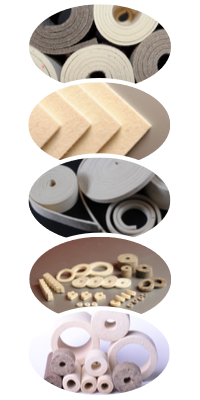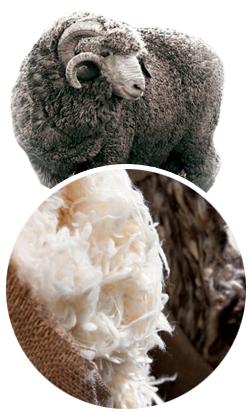What is felt?
Wool felt is a traditional and exceptional natural material. It is even considered to be the first fabric in human history to be woven from sheep wool more than 10,000 years ago in Asia Minor. Thanks to the natural migration of nations and its versatile use, felt has spread all over the world and has become an integral part of our lives. It is easily degradable and 100% renewable.
Wool characteristics:
- wool absorbs 40% water and 100% moisture,
- hydrophobic and hydrophilic properties,
- the highest absorbency compared to other fibers,
- fire resistant, does not melt,
- the ignition point is at 600 ° C,
- capable of decomposition,
- renewable material.
How is felt made?
- Combing: Sheep wool must first be combed. In this process, the impurities are removed and the wool fibers are straightened and untangled. The straight fibers continue the production process as a continuous layer of wool fibers.
- Layering: this layer of wool fibers is thin and relatively thin. Therefore, it is necessary to stack several such layers on top of each other, which act as fine layers of fluffy "cotton wool". This mixture is still gentle and inhomogeneous.
- Felting: to achieve a dense, homogeneous and firm surface of the felt, the fluffy layers of wool fibers are directed into the felting process. Here they are affected by a combination of moisture, heat and friction, which triggers the felting process, during which the wool fibers intertwine and compact. In this process, the wool fibers become a felt that is dense, strong and homogeneous.
- Rolling: in order to obtain the optimum density, the felt undergoes a rolling process in which it is further compacted by mechanical action.
- Drying: as the felt is wet after production, it must be dried.
- Cutting: cutting shortens all long wool fibers that protrude unnecessarily from the surface of the felt.
- Pressing: the finished wool felt should have a flat and homogeneous surface and the correct thickness. This is done by the felt pressing process, in which the felt passes through heated rollers, which compensate for all imperfections.
- Winding or shortening: in the last step, the finished felt is wound on paper tubes in the form of rolls or cut into the form of finished felt boards.
Our felt options
 Wool felt from our offer is produced according to the European standard DIN 61200, which is the equivalent of British, American or Russian specifications (BS4060, SAEF & GOST). Felt is produced for us only by certified manufacturers with whom we have many years of experience. However, we do not produce felt in our production in Slovakia.
Wool felt from our offer is produced according to the European standard DIN 61200, which is the equivalent of British, American or Russian specifications (BS4060, SAEF & GOST). Felt is produced for us only by certified manufacturers with whom we have many years of experience. However, we do not produce felt in our production in Slovakia.
We supply wool felt in various thicknesses (from 1 mm) and densities (from 0.18 g / cm3), depending on the final application. The basic colors of wool felt are natural white and gray. The basic form of felt is in rolls wound on a paper tube or in sheets. We also have felt solutions for you in the form of finished products or semi-finished products. These are, in particular, felt strips, cut-outs and cut-outs, rollers, discs, bodies for a wide range of applications.
Wool felt solutions can be used in almost all industries. Here are the main examples of technical use:
- seals and insulation,
- polishing and finishing,
- lubrication, lubrication and application,
- maintenance of machinery and equipment,
- work pads,
- fillings.
Choose from our offer felt exactly according to your ideas. Here are the main categories:
- WOOL FELT
- DECORATIVE AND DESIGN FELT
- Coloured wool felt
- Coloured synthetic felt
- Design felt TEXFEL INTERIORS
- Stiffened felt TEXTIL FELT 1000
- Stiffened felt TEXTIL FELT 700
- Stiffened felt TEXTIL FELT 500
- Stiffened felt TEXTIL FELT 400
- Coloured soft felt TEXTIL FELT 200
- Coloured stiffened felt TEXTIL FELT 170
- Creative felt FELTRO
- Felt for pin boards PE150/1.0
- Coloured felt PECF100
- Acoustic design panels FELTACO
- Creative packages
- SELF-ADHESIVE FELT
- NEEDLE FELT
- FELT PRODUCTS
- SPECIAL OFFER






